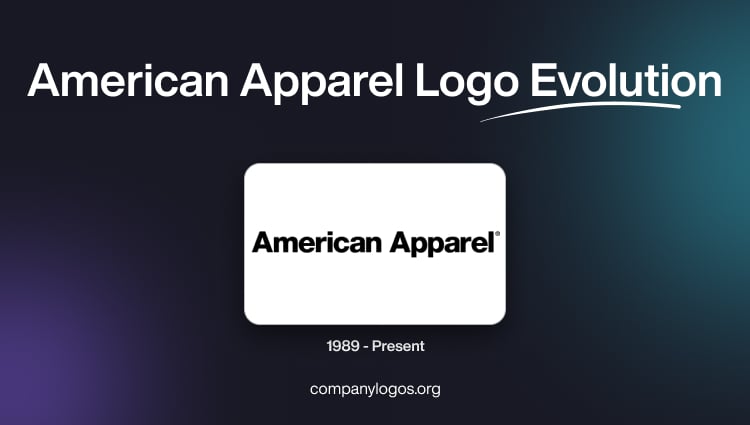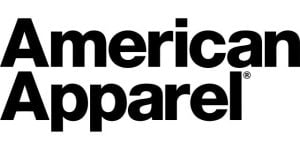
American Apparel is a renowned American clothing company that was founded in 1989 by a Canadian entrepreneur, Dov Charney. It began as a small wholesale business in North Carolina and focused on producing high-quality, American-made basic garments such as T-shirts. The company relocated to Los Angeles in 1997, where it grew from a wholesale supplier to a popular retail brand.
American Apparel is known for its commitment to ethically manufactured, sweatshop-free clothing produced domestically in the United States. The logo of the company has remained consistent since its founding in 1989. The article looks into the American Apparel logo and various aspects related to it, among other details of the company.
The Genesis of the American Apparel Logo (1989 – Present)
The American Apparel logo is text-based and features the brand name in two ways. The first one features the brand name in a single line, while the other features the brand name in two levels – both in a title case. Bold and eye-catching, the minimalist brand name is executed using a modern and grotesque sans-serif typeface, which gives it a stylish look. Designed in black and set against a white background, the logo design evokes a sense of modernity and confidence.


The Elements of the American Apparel Logo
Font
The logotype of American Apparel is written using a modern, grotesque sans-serif typeface developed by Max Miedinger to convey a contemporary and stylish appearance. It is similar to Helvetica Black and Bold.
Colour
The logotype is designed using black and set against a white background to create impact.
The History of American Apparel
American Apparel was founded in 1989 by a Canadian entrepreneur, Dov Charney. He initially started it as a wholesale business in South Carolina focused on producing high-quality blank T-shirts. In 1997, the company relocated to Los Angeles, where Charney partnered with a local sewing shop owner, Sam Lim. By 2000, American Apparel had moved into a large manufacturing facility in downtown Los Angeles.
The company opened its first retail store in 2003, and it rapidly expanded to 143 stores across 11 countries by 2007. American Apparel became well known for its ethically made, sweatshop-free clothing. It is proudly manufactured in the USA and is characterised by minimalist, multi-coloured apparel. The brand emphasised fair labour practices by paying wages higher than average in the garment industry and offering benefits to factory workers.
However, despite its growth, American Apparel faced controversies as well. These included sexual harassment lawsuits against Charney and financial difficulties starting around 2010. The company’s auditors resigned due to unreliable financial statements, which triggered investigations by regulatory authorities.
After several years of struggles, including bankruptcy, American Apparel went through a significant transformation. It remains recognised to this day for its contributions to American-made apparel and socially conscious manufacturing in the fashion industry. Its history is marked by rapid growth, bold marketing, and ethical labour practices, as well as daunting corporate challenges.
Interesting Facts About American Apparel
- American Apparel began in 1989 when Dov Charney, a Canadian entrepreneur, started importing plain T-shirts from the U.S. to Canada. It evolved into a full-fledged clothing brand by the early 2000s.
- Unlike many fashion brands that outsourced production, American Apparel was famous for manufacturing all its products in Los Angeles. It employed thousands of local workers and promoted fair wages.
- Its simple, high-quality cotton T-shirts became a fashion staple worldwide. The brand helped redefine the idea that “basics” could be fashionable.
- American Apparel became famous (and sometimes infamous) for its provocative ad campaigns, which often featured real employees and non-professional models. These ads sparked debates about sexuality in marketing and brand ethics.
- The company controlled every step of production, from design and manufacturing to marketing and retail, all under one roof in Los Angeles. This was rare in the fashion industry and allowed faster innovation.
- Before “ethical fashion” became trendy, American Apparel championed sweatshop-free manufacturing. It offered above-average wages and healthcare benefits to workers.
- Despite its popularity, the company faced financial troubles and leadership controversies, which led to bankruptcy in 2015. It was later acquired by Gildan Activewear in 2017.
- After its acquisition, American Apparel was relaunched in 2018 as an online-only brand. It focused again on its core strengths: classic designs, ethical production, and simplicity.
- Modern American Apparel emphasises diversity and body positivity. It features models of various ethnicities, sizes, and backgrounds, which is a shift from its earlier image.
- The new era of American Apparel places focus on sustainable materials, responsible sourcing, and eco-friendly manufacturing practices. These aspects align with the global trends in conscious fashion.
Finally
The American Apparel logo has not changed since the time of the founding of the company. It has consistently mirrored the journey of the brand from a bold, countercultural startup to a modern, ethically conscious fashion icon. Throughout its timeline, the logo has maintained a minimalist and typographic style. The logo is a reflection of the company’s focus on simplicity, authenticity, and timeless design.